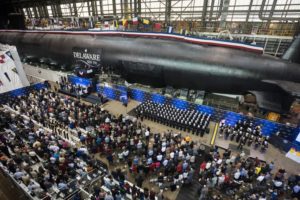The Trump administration last week asked Congress to fund a second Virginia-class attack submarine in fiscal year 2021, reversing its position in the original budget request.
Office of Management and Budget (OMB) Director Russel Vought sent a letter Nov. 25 to the leadership of the House and Senate Appropriations committees and their defense subcommittees stating the administration supports the House Appropriation Committee’s recommendation to fund a second Virginia-class submarine in FY ’21 and the Senate panel’s addition of $472 million in advance procurement “to assume the submarine industrial base and its suppliers of a committed acquisition and funding strategy.”

Vought noted “with this letter, the Administration is requesting full funding for the procurement of the 10 submarines under the current multiyear procurement agreement.”
Last December, the Navy awarded General Dynamics’ Electric Boat [GD] a $22.2 billion contract for nine Block V Virginia-class submarines with an option for a 10th vessel covering fiscal years 2019 – 2023. The 10th boat is expected to raise the total contract value to over $24 billion (Defense Daily, Dec. 2, 2019).
These vessels are scheduled to be delivered from 2025 to 2029.
When the FY ’21 budget request was first released earlier this year, the administration requested only one attack submarine, after requesting two the previous year and planning last year to request two this year, incurring criticism in Congress (Defense Daily, Feb. 12).
During a hearing the month the budget was released, former Acting Secretary of the Navy Thomas Modly told the House Armed Services Seapower Subcommittee the budget was the result of choices and admitted it slowed down the trajectory to 355 ships or more. The submarine was initially taken out of the administration’s budget request reportedly to help fund a higher National Nuclear Security Administration funding (Defense Daily, Feb. 27).
In his letter, Vought acknowledged the connection between the second attack submarine and the increased Energy Department funding. He argued these investments in naval forces “should not come at the expense of fully funding requests in the FY 2021 Budget request for the nuclear deterrent in both DoD and the Department of Energy. The Administration looks forward to working with the Congress to identify offsets for this urgent requirement.”
Ultimately, the House version of the FY ’21 defense appropriation bill added $2.6 billion to fully fund the second Virginia-class submarine while the Senate’s version only added the $472 million in advance procurement funds (Defense Daily, June 25).
During the House Armed Services Committee’s FY ’21 defense authorization bill markup, Seapower Subcommittee Chairman Joe Courtney (D-Conn.) had a staffer explain if the second attack submarine in FY ’21 was not authorized and appropriated it could impact the Columbia-class submarine workforce and schedule (Defense Daily, July 2).
The staffer said GD Electric Boat would still build a second vessel due to the multiyear contract, but this would move other work forward to maintain the build schedule. However, by the end of FY ’23, GD would run out of attack submarine construction work to do and start laying off recent hires who they expect would work on the second year of Columbia-class submarine work.
In his letter, Vought said the Defense Department recently completed its comprehensive study of the country’s naval force structure and “requirement to prevail in a great power competition.”
“The results of this study confirm the need for the immediate acceleration of Virginia-class submarine construction to at least two per year over the next five years to preserve the Nation’s naval supremacy,” he continued.
This is a reference to how former Secretary of Defense Mark Esper outlined his plan for a 500-ship fleet by 2045, known as Battle Force 2045. This includes reaching 355 traditional ships by 2035 and the remainder made of unmanned vessels.
During his unveiling of the plan, Esper emphasized the importance of building more submarines, calling for an attack submarine force of 70 to 80 vessels (Defense Daily, Oct. 6).
“If we do nothing else, the Navy must begin building three Virginia-class submarines a year as soon as possible,” Esper said.